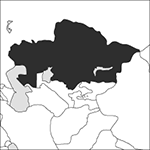
Source: MAPS IN MINUTES™ © RH Publications (1997)
Capital:
Astana
Area:
2,724,900 sq km (1,052,090 sq miles)
Population:
17,736,896 (2013 est)
Currency:
1 tenge=100 tiyn
Religions:
Muslim 70.2%; Eastern Orthodox 23.9%; other Christian 2.3%
Ethnic Groups:
Kazakh 63.1%; Russian 23.7%; Uzbek 2.8%
Languages:
Kazakh, Russian (both official)
International Organizations:
UN; OSCE; Commonwealth of Independent States; Euro-Atlantic Partnership Council; WTO
A country of western central Asia, stretching for some 3200 km (2000 miles) from the Caspian Sea to Xinjiang. It is bounded by China on the east, Kyrgyzstan and Uzbekistan on the south, the Caspian Sea and Turkmenistan on the west, and Russia on the north.
Physical
In the north a belt of fertile steppe with rich, black earth (chernozem) provides scope for cultivation. Southward, however, it becomes more arid, degenerating into the Kara-Kum desert. On the east Caspian coast, oil and natural gas are found. Further east, towards the Aral Sea, is a clay desert plateau; east and south-east of it, sand desert. To the east of this are the stony Kazakh uplands with huge coal deposits in their northern slopes and copper in their southern ones. Here is the extensive and partly saline Lake Balkhash, which is slowly evaporating.
Economy
Kazakhstan has rich and varied mineral deposits, including oil, natural gas, tungsten, copper, lead, uranium, diamonds, coal, iron ore, and zinc. The mainstay of the economy is the exploitation of these resources, especially oil; however, the government is attempting to diversify the economy into other industries. Grain production and livestock-rearing dominate agriculture.
History
For centuries, the steppelands of Kazakhstan were the home of nomadic Kazakh herdsmen, ruled by Mongol khans, whose territories were steadily annexed by Tsarist Russia during the 19th century, the khanate being abolished in 1848. A nationalist movement developed in the early 20th century and there was a bloody anti-Tsarist revolt in 1916. In 1917 a national government was proclaimed in the capital Alma Ata; but this was suppressed by the Red Army, which occupied the country (1919–20), and large numbers of Russians and Ukrainians moved in. It became the Kazakh Autonomous Soviet Socialist Republic, which in 1936 became a full republic within the Soviet Union. Vast areas (some ten million acres) were developed for agriculture as state farms, while there was also heavy industrialization during the 1930s and 1940s. Large mineral deposits, including uranium, were discovered and exploited, particularly around Lake Balkhash. After 1941 Stalin’s regime forcibly moved German, Greek, and Armenian deportees into the republic. In October 1990 it proclaimed its sovereignty, and in December 1991 its independence was recognized. The Communist-derived ruling party remained in power, under President Nursultan Nazarbayev. A new constitution was approved by referendum in 1995 and gave Nazarbayev ultimate power. He was re-elected in 1999 but observers condemned the elections as unfair. In December 1997 the capital was transferred from Almaty to Aqmola, which was renamed Astana. Nazarbayev was again re-elected in 2005, 2011, and 2015, when he won nearly 98 per cent of the vote. A decline in the price of oil brought economic growth almost to a stop in 2016 and the government initiated an economic revival plan. In 2017 Nazarbayev announced that the Kazakh language would henceforth be written in Latin rather than Cyrillic script, a further move away from Russian influence. He announced his surprise resignation in March 2019, but will remain as head of the governing party and be known as Leader of the Nation.
- blade
- bladed
- Blagden, Sir Charles
- Blaha, John Elmer (1942– )
- Blaine, James Gillespie (1830–93)
- Blair House Agreement
- Blair, Tony (1953)
- Blake
- Blake, Robert (1599–1657)
- Blakeslee, Albert Francis
- blanc fixe
- Blanc, Louis (1811–82)
- blancmange function
- Blanco, Antonio Guzmán
- Bland-Altman plot
- Blandford–Znajek process
- blank
- blank-and-burst
- blank character
- blanket bog
- blanketing
- blanking
- blanking level
- Blanqui, Louis Auguste (1805–81)
- -blast